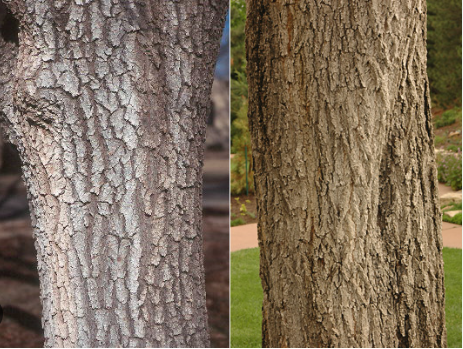
Ulmus pumila, also referred to as Siberian elm or Asiatic elm is usually a small to medium-sized, often bushy, deciduous tree growing to 25 m tall. It is native to Central Asia, eastern Siberian, the Russian Far East, Mongolia, Tibet, northern China, India and Korea. The tree has an open rounded crown and slender, spreading branches.
Siberian Elm was introduced from northern China and eastern Siberia and has since naturalized across the United States, particularly in the Midwest and Great Plains regions. This tree is invasive nature, forming dense thickets that crowd out native plants and reduce forage for wild animals and livestock.
There is some debate about the exact year the Siberian Elm arrived in North America. Some sources point to 1860, while others suggest Professor John George Jack introduced it in 1905, followed by Frank Nicholas Meyer and then . Regardless of the precise date, it entered the scene during the 19th century, likely as a boulevard and windbreak tree. Early nursery catalogs even listed it in the 1800s.
Over time, the Siberian Elm has been used in hybridization efforts to develop elm varieties resistant to Dutch Elm Disease (DED), a fungal disease that devastated many elm populations. The tree’s disease resistance and prolific seed production have contributed to its widespread naturalization, but its aggressive seeding habit and brittle branches have also led to it being considered invasive in some areas.
Siberian elm is somewhat similar to American elm (U. americana), slippery elm (U. rubra) and rock elm (U. thomasii), all of which are native to the Great Lakes region. The leaves of American and slippery elm are double or more the size of the leaves of Siberian elm, and are also notably uneven at the leaf base. Rock elm leaves are similar in size and shape to Siberian elm, but its older bark is distinctly ridged and corky, its seeds are hairy, and its crown is narrower than Siberian elm. Rock elm is also quite rare in much of its range. All of the native elms have double toothed leaf edges (the large teeth each have small, finer teeth), while the edges of Siberian elm leaves are singly toothed.
Siberian elm is most similar in appearance to the exotic ornamental lacebark elm (U. parviflora), which also has small leaves that are almost even at the base. Lacebark elm leaves are usually glossier on the top surface and more leathery in texture than Siberian elm. Lacebark elm flowers in the fall, not the spring. Finally, mature bark of lacebark elm has a distinct, lacey pattern, while Siberian elm bark has vertical ridges.
Identifying Physical Characteristics
- Growth Habit: The tree has an open, rounded crown and slender, spreading branches.
- Size and Shape: It is a large, fast-growing deciduous tree, reaching up to 50’ to 70’ tall with a vase-shaped to rounded crown up to 40’ wide at maturity. Under difficult growing conditions, it can be much shorter and shrubbier.
- Leaves: The leaves are small with a single serrated edge. They are dark green and smooth above, pale and nearly hairless on the underside. The base of the leaves is tapered or rounded.
- Flowers: The flowers are small, greenish, lack petals, and occur in small drooping clusters of 2-5. Flowers appear between March and May before leaves develop.
- Fruits & Seeds: The fruit is a flat, circular, winged fruit (samara) that is deeply notched at the tip and contains one circular seed with a smooth surface, about ½” comprehensive.
- Bark: On mature trees, the bark is dark gray with shallow grooves. Silver-gray twigs have a zig-zag shape with a leaf bud at each bend.
- Branches: The branches are yellowish-gray and may be pubescent (hairy) in young trees. Unfortunately, these branches are a weak point, being brittle and susceptible to breaking under heavy snow, ice, or strong winds.
- Twigs: Twigs are silver-gray zig-zag shape with a leaf bud at each bend. They are silver-gray in color.
Habitat and Growing Conditions
- It is adapted climates, including dry and cold conditions. It is resistant to Dutch Elm Disease and has been used to develop other elms with resistance.
- It grows well in full sun and is tolerant of partial shade.
- It is highly drought-tolerant but also able to grow in areas with moderate moisture.
- The tree has brittle branches that can break easily, especially during storms, which can create a mess and pose a safety hazard.
Interesting Facts about Siberian Elm
- The species was described by Peter Simon Pallas in the 18th century from specimens from Transbaikal.
- The tree is short-lived in temperate climates, rarely reaching more than 60 years of age, but in its native environment may live to between 100 and 150 years
- The tree was brought to America in the mid-1800s as a boulevard and windbreak tree due to its hardiness and rapid growth.
- It is considered invasive in some areas due to its aggressive seeding habit and ability to self-seed prolifically.
- It is a fast-growing tree, it shoots up quickly, reaching maturity faster than many other elm species.
- Branches are brittle and prone to breaking under heavy snow, ice, or strong winds, posing a safety hazard.
- It is resistant to Dutch Elm Disease (DED).
- Dense foliage makes it a valuable windbreak, protecting crops and homes on the Great Plains.
- The Siberian elm will grow at almost any site. It has even adapted well to places like Minnesota.
- Native to Siberia, China, and Korea.
- Common problems include cankers, scale insects, borers, leaf spots, and Japanese beetles.
- While it is very resistant to drought and severe cold, and able to grow on poor soils, its short period of dormancy, flowering early in spring followed by continuous growth until the first frosts of autumn, renders it vulnerable to frost damage.
Siberian Elm – Identification Guide (Pictures)
Leaves

Bark

Flowers
